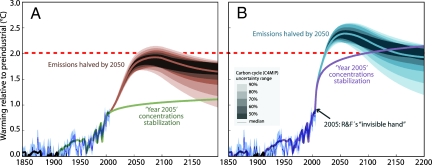Fig. 1.
Comparison of GMT development as resulting from fixing concentrations at 2005 levels [“concentrations stabilization scenario” (CSS)] and halving global Kyoto-GHG emissions by 2050 relative to 2000 levels [“mitigation scenario” (MS)], respectively. (A) Freezing of current air pollution and GHG levels in CSS, and concomitant gradual decrease of air pollution in MS. (B) The “invisible hand” of R&F (1) eliminates all forcings except those of long-lived GHGs and tropospheric ozone in 2005, i.e., aerosol cooling vanishes, in both CSS and MS. Climate sensitivity is chosen as 3°C throughout; other climate parameters (such as those affecting ocean inertia) are calibrated toward HadCM3; carbon cycle parameters are varied for representing the range of ten C4MIP models (14) by using MAGICC 6.0 (13). Historical observations of GMT are taken from HadCRUT3v (15).

